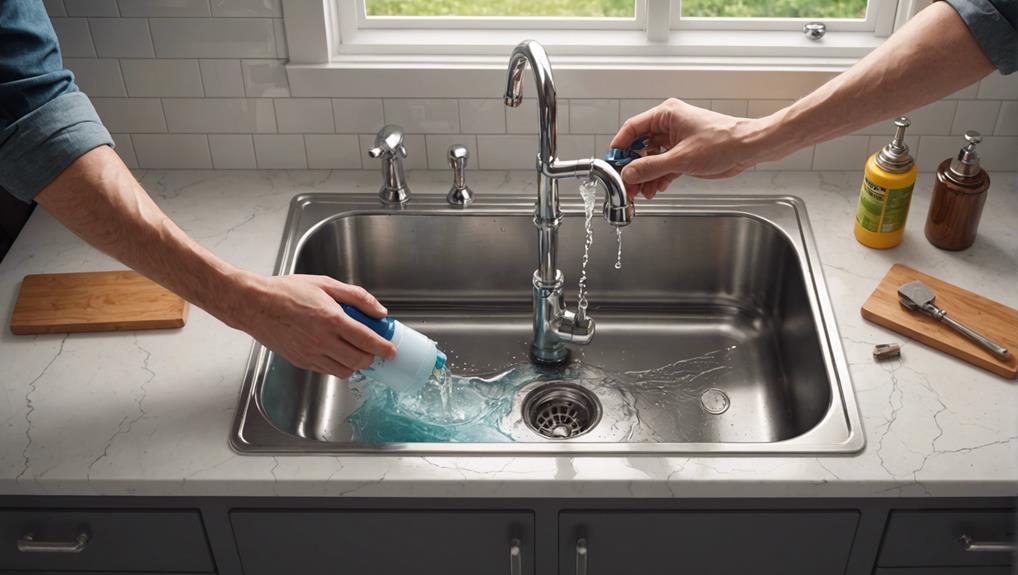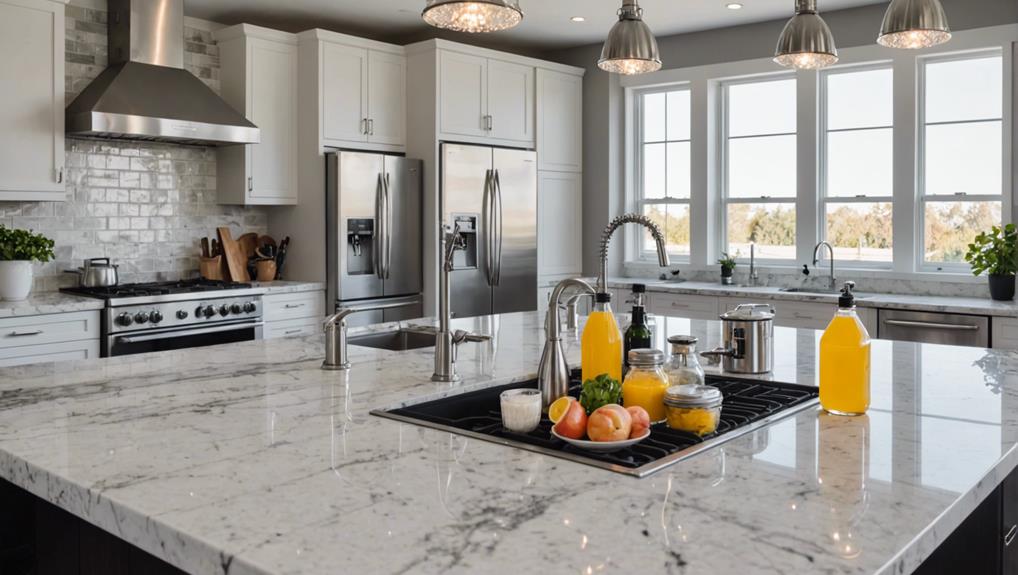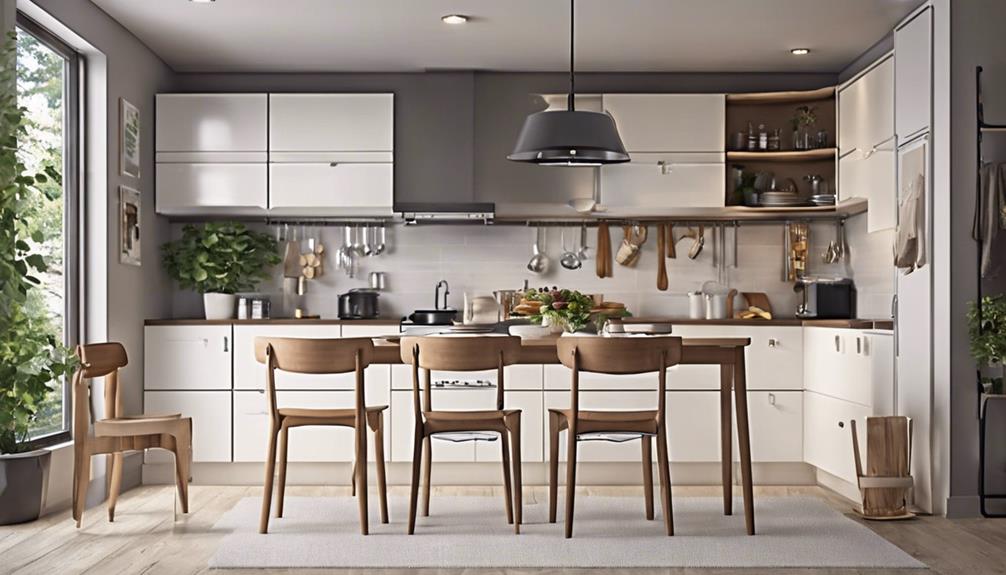
Fixing a Kitchen Sink Overflow in 5 Easy Steps
To fix a kitchen sink overflow in 5 easy steps, start by removing any standing water with a bucket or towel to prevent surface damage. Next, pour baking soda down the drain followed by white vinegar; cover to maximize the chemical reaction that dislodges debris. After the bubbling stops, pour boiling water to dissolve grease and debris, but use caution with PVC pipes. Use a cup plunger to create suction and dislodge deeper blockages, applying petroleum jelly for a better seal. Finally, run hot water to break down remaining grease and maintain the drain. Discover more techniques for a thorough solution.
Key Takeaways
- Remove standing water using a bucket or towels to prevent further damage.
- Pour baking soda into the drain, followed by white vinegar, to dislodge debris.
- Pour boiling water down the drain to dissolve grease and debris.
- Use a cup plunger with a complete seal and vigorous motion to clear the blockage.
- Run hot water to break down and flush out remaining grease and debris.
Remove Standing Water
To effectively address a kitchen sink overflow, begin by using a bucket or towels to remove any standing water from the sink basin. The bucket method involves carefully scooping the water into a bucket, reducing the risk of spills and facilitating easy disposal. This method is particularly effective for larger volumes of water.
Conversely, the towel method is ideal for smaller amounts of water or for soaking up residual moisture. Use a highly absorbent towel to blot and absorb the standing water, wringing it out into a separate container as needed.
Avoid using the sink or running water until the standing water is completely cleared to prevent exacerbating the overflow situation. Wipe down surrounding surfaces, such as countertops and cabinet exteriors, to mitigate the risk of water damage or mold growth. Ensuring that the area is thoroughly dry before proceeding with further steps is essential to maintaining a safe and clean workspace.
Proper disposal of the removed standing water is key to preventing spills or accidents. Dispose of the water in an appropriate drainage area, ensuring there is no risk of additional overflow or contamination. By following these methods, you effectively prepare the area for subsequent repair steps.
Use Baking Soda and Vinegar
Initiate the clog-removal process by pouring one cup of baking soda directly into the drain. This initial step in the DIY cleaning approach leverages the abrasive yet gentle nature of baking soda to begin addressing any blockages.
Next, follow up with one cup of white vinegar. The combination of these two natural solutions sets off a chemical reaction that produces carbon dioxide gas, which manifests as a fizzing action.
This reaction is important as it can effectively dislodge debris and break down organic materials causing the overflow. It is essential to cover the drain immediately after introducing the vinegar. This containment maximizes the effectiveness of the reaction by ensuring the pressure generated is directed downwards, thereby enhancing the dislodging process.
Allow the baking soda and vinegar mixture to sit and work its magic for at least 15 minutes. During this period, the natural solutions continue to interact, breaking down the clog in a non-toxic, environmentally friendly manner.
This method not only guarantees the safety of your plumbing system but also avoids the harsh chemicals often found in commercial drain cleaners. This foundational step greatly contributes to restoring the free flow of water in your kitchen sink.
Pour Boiling Water
Once the baking soda and vinegar have had sufficient time to work, carefully pour a kettle of boiling water down the drain to dissolve any remaining grease and debris. This step leverages the high temperature of boiling water to break down fats and oils that typically contribute to clogs. By dislodging trapped particles, boiling water helps guarantee proper drainage and prevent future clogs.
The benefits of using boiling water extend beyond immediate clog removal. Regularly pouring boiling water down the kitchen sink can serve as a preventative maintenance measure, reducing the accumulation of grease and food particles over time. This simple yet effective method can help homeowners avoid the hassle and cost associated with more severe blockages.
It's important to note that while boiling water is generally safe for most types of plumbing, caution should be exercised with PVC pipes. The high temperature can potentially weaken or damage these materials. If your home has PVC pipes, consider using hot, but not boiling, water to mitigate risk.
Repeat the process as needed to make sure the blockage is fully cleared. This straightforward technique is an excellent addition to any homeowner's toolkit for maintaining a smoothly functioning kitchen sink.
Plunge the Sink
An essential step in addressing a kitchen sink overflow is to use a cup plunger specifically designed for sink drains. Unlike flange plungers, which are intended for toilets, cup plungers are optimized for flat surfaces, such as kitchen sinks, providing a better seal and more effective suction.
To begin, guarantee the plunger covers the drain entirely to maximize the suction power. A common mistake in plunger technique is failing to achieve a complete seal, which diminishes the effectiveness of the plunging action. Applying petroleum jelly around the rim of the plunger can enhance the seal, making the process more efficient.
When plunging, use a vigorous up-and-down motion. This dynamic action helps dislodge the clog by creating substantial pressure and suction forces within the pipe. It's advisable to repeat the plunging process several times if the initial attempt does not clear the blockage.
Among the types of plungers, the cup plunger is favored for its simplicity and efficacy in handling sink overflows. However, it is important to acknowledge its limitations; it may not be as effective for deeper or more stubborn blockages, where alternative methods or professional intervention might be necessary. Employing the proper plunger technique and understanding the pros and cons of different plungers are key to successfully resolving a kitchen sink overflow.
Run Hot Water
To address a kitchen sink overflow effectively, running hot water can be instrumental in breaking down grease and debris that may be obstructing the drain. The increased water temperature helps to soften and dissolve fatty substances, which are common culprits in drain blockages. This step is particularly important in drain maintenance, ensuring that minor clogs are addressed before they escalate into more significant plumbing issues.
Begin by running the hot water tap at its maximum temperature for a few minutes. This sustained flow of hot water helps to dislodge and push through the accumulated debris in the drain system. The heat not only softens the grease and food particles but also aids in their movement down the pipes, thereby reducing the risk of further obstructions.
It is essential to maintain the water temperature at a high level during this process, as cooler water may not be as effective in breaking down stubborn clogs. For best drain maintenance, consider combining this step with the use of a plunger or a drain snake for more persistent blockages.
Regularly running hot water through your kitchen sink can also serve as a preventative measure, minimizing the likelihood of future overflows.
Frequently Asked Questions
How to Fix Kitchen Sink Overflow?
To address a kitchen sink overflow, prioritize overflow prevention by shutting off the water supply. Perform thorough sink cleaning using a plunger, boiling water, and a plumbing snake. If unresolved, consult a professional plumber.
How Do You Unclog a Sink in 5 Easy Steps?
To unclog a sink in 5 steps, remove standing water, use a plunger, deploy a drain snake for deeper blockages, apply a baking soda and vinegar mixture followed by hot water, and if needed, manually clear the trap.
How to Fit a Sink Overflow Pipe?
To fit a sink overflow pipe, select appropriate pipe materials such as PVC or stainless steel. Utilize fitting tools like a pipe wrench, plumber's tape, and sealant. Confirm all connections are tight and leak-free for best performance.
How to Remove Kitchen Sink Overflow Cover?
To remove a kitchen sink overflow cover, first identify the overflow types. Use appropriate cleaning tools such as screwdrivers or pliers to carefully detach the cover, ensuring not to damage the surrounding components during the process.
Conclusion
The efficient resolution of a kitchen sink overflow can be achieved through a systematic approach. By removing standing water, utilizing baking soda and vinegar, pouring boiling water, plunging the sink, and running hot water, the blockage can be effectively cleared.
This method leverages basic household items and practical techniques, ensuring a cost-effective and accessible solution. Adherence to these steps can prevent future overflow incidents and maintain the functionality of the kitchen sink.



Leave a Reply